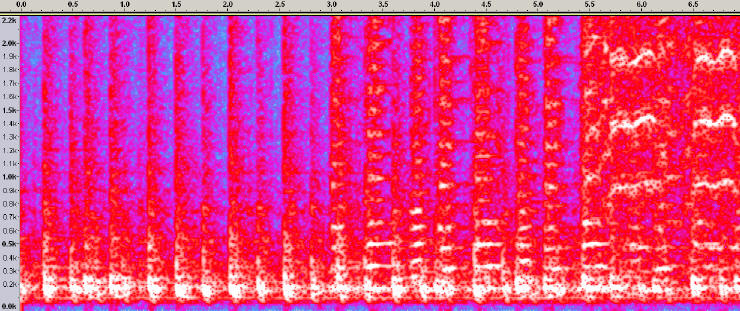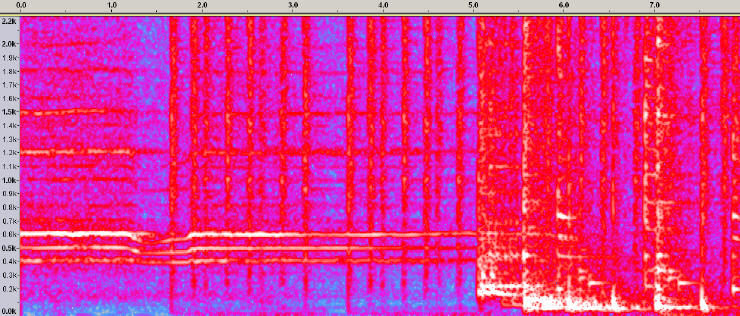
The spectrogram was computed from a clip taken from Track 13 of the CD Benny Goodman Orchestra: Jazz Collector Edition. The clip begins at 3:20 and lasts for 7 seconds. The recording is available from Tower Records or from Amazon.
Since this recording is not that accessible, we provide here three additional examples of percussion in spectrograms, and how percussion compares with other tones. The first example is a clip from a different version of Sing, Sing, Sing. The second example is a clip from the song, Buenos Aires, from the movie soundtrack for Evita. The third example is a clip from the Stevie Wonder song, Superstition.
This spectrogram is from a different recording of Sing, Sing, Sing by the Benny Goodman Orchestra:

The first 3 seconds to the spectrogram show multiple drum strikes. At 3.0 seconds, trumpet notes begin to appear. Their longer, horizontal harmonics contrast with the vertical bands of the drum strikes, and also show some pitch bending. More extended, pitch-bent harmonics from the orchestra's horn section appear slightly before 5.5 seconds. You can listen to this clip on Spotify. It begins at 0:05.
You can buy this recording from Amazon, or iTunes, or Spotify.
This spectrogram is from a recording of Buenos Aires for the movie soundtrack of Evita.

The beginning of the spectrogram shows long, horizontal harmonics for whistle tones. Notice the bending of the harmonics around 1.25 seconds. In the midst of this pitch bending, there begins a sequence of rapid hand claps. The sharp, percussive sounds of the hand claps appear as thin, vertical bands in the spectrogram. In contrast to the hand clap percussion, there is drumming percussion beginning at 5.0 seconds. The drum percussion shows both vertical bands--at the beginning of the drum strikes--and also some horizontal, harmonic bands. These horizontal harmonics show both lower pitch and higher pitch fundamentals coming from the low and high notes of the latin drums. You can listen to the clip for this spectrogram on Spotify. The clip begins slightly after 0:01.
You can buy this recording from Amazon, or iTunes, or Spotify.
This spectrogram is from the beginning of the recording of the Stevie Wonder song, Superstition.
.jpg)
The first 10 seconds shows the thin vertical bands of percussion, in this case drum beats. The very short, horizontal, harmonics at about 180 Hz and 360 Hz correspond to higher pitch drum beats. Those beats are interspersed with bass drum beats, which do not exhibit those short duration harmonics. At about 10.0 seconds, multiple clavinet tones are played with a ''funky'' rhythmic pattern. The percussive onset of those clavinet tones is apparent in the vertical bands that occur at the start of each tone. The harmonics that continue on horizontally from those vertical bands create the tonality of the clavinet tones. Finally, at about 29.0 seconds, Stevie Wonder begins singing. The harmonics of his vocals show up as the curved and vibratoed bands. You can listen to the clip for this spectrogram on Spotify. The clip begins immediately.
You can buy this recording from Amazon, or iTunes, or Spotify.